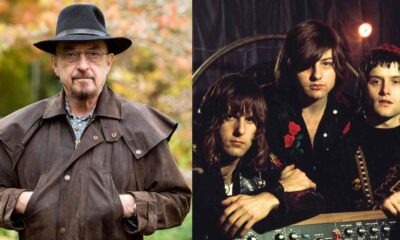ARTICLES
The 2 drum fills that Phil Collins listed as favorites
Although Phil Collins became a complete artist over the decades, being one of the few ones in history who were able to sell more than 100 million records worldwide both as a member of a band and as a solo act, his first love were the drums and it continued to be a fundamental part of his songwriting.
He first achieved fame as the musician behind the Genesis drum-kit and got even more recognition when he was forced to become their frontman after Peter Gabriel decided to leave in 1975. After a few hits with Genesis during the rest of that decade his career really took-off when he also focused on his solo career, becoming one of the biggest pop stars of the 80s.
Over the decades he talked a lot about his career and even revealed in an interview for his podcast “A to Z” in 2021 (Transcribed by Rock and Roll Garage), which were two of his favorite drum fills.
The 2 drum fills that Phil Collins said he loves
“In the Air Tonight”

“Well, I gotta put ‘In the Air Tonight” somewhere in there I guess. You know, the “badam, badam, badam, bup bup, bup. (…) You know, some songs don’t need that stuff. I mean, a lot of songs don’t need that stuff. I think it’s down to taste. When you feel you have to do something and resist. I remember doing a session for Tears for Fears for ‘Woman In Chains’. I knew Curt pretty good and what was his name… Roland, yeah.”
“They got me down and what they really wanted in this drum entry, they wanted to sound of ‘In The Air Tonight’. I said ‘I can’t do that’, it’s been done. I did it and can’t do it, I have to do something else. And when someone is expecting something like that it’s very difficult to make it anything else work. So I did something and they seemed to be happy with it. But I don’t think they were. So, sometimes when you do something and it sounds great, you have to close the door on it and move on, find something else.”
He continued:
“‘Easy Lover’ was littered with lots of good drum fills on that. That was just because we didn’t think about the tape rolling, we were just recording it. We were just about to finish but we have been writing this song and we just put a rough version down. So you don’t really care because you think you will do another version anyway. In the next day we came in, listened to it and liked it. So we kept it, but that’s the way to do it. You don’t tell a drummer you’re going for a take. Otherwise you gonna get all this stuff thrown in. The best way to catch people is when they’re not expecting you,” Phil Collins said.
One of Phil Collins’ biggest hits, “In the Air Tonight” was first featured on his 1981 debut solo album “Face Value”. He co-produced the track with Hugh Padgham and recorded with Daryl Stuermer (Guitar), John Giblin (Bass) and L. Shankar (Violin). The song ended up being a number one hit in several countries. It reached position number 19 on the US Billboard Hot 100.
“Intruder”

Another drum fill mentioned by Collins was “Intruder”, for which he only said: “The sound of ‘Intruder”, you know, Peter Gabriel.” The track was written by his ex-bandmate and first featured on his third studio album released in 1980.
The track also used the so-called “gated reverb”, which was a drum sound created by Collins and the producer Hugh Padgham. So it’s not a coincidence that Collins played the drums in that song.
Besides both artists, the track was also recorded by Morris Pert (Xylophone, bell), Larry Fast (Synthesizer) and David Rhodes (Guitar).
In an interview with John Edginton in 2014 (Transcribed by Rock and Roll Garage) he recalled how he discovered that drum sound and gave “Intruder” was an example.”If you put a compressor on a sound, if you hit a snare drum, if you put a compressor on it, it will last longer (the sound). Because you’re compressing it and then letting it open up. So you will get the room sound, you will get the person breathing. If you put a noise gate on that and cut it off, (you will) get a gate cutting the compression off.”
He continued:
“Now, you can adjust those so that the gate shuts earlier or later, whatever. So you get a (shorter sound) which is the gate cutting it off. The compressor makes the sound longer and the gate cuts it off. So you get quite a sharp edge to the sound. It’s a sharp ending edge, you know. So I was with my headphones on. (…) You kind of compose a rhythm and a tempo for that rhythm with the sound that you’re hearing in the headphones, which is being changed by someone (who is adjusting).”
“Once he’s got it, it won’t change it. So that’s how we arrived (to the setup) and so I’ve played and Peter (Gabriel) heard it, and I heard and said “Oh, that sounds fantastic”. I was almost wanting to take a tape home for me. But Peter said ‘No, I’d like you know, just play that for 10 minutes and I can use that. So that’s how that ‘Intruder” sound was kind of discovered, if you like,” Phil Collins said.
That experience led him Collins to become a friend of Hugh Padgham, making them not long after that record Collins’ debut album together and of course, using that same technology in the song “In The Air Tonight”.
I'm a Brazilian journalist who always loved Classic Rock and Heavy Metal music. That passion inspired me to create Rock and Roll Garage over 6 years ago. Music has always been a part of my life, helping me through tough times and being a support to celebrate the good ones. When I became a journalist, I knew I wanted to write about my passions. After graduating in journalism from the Pontifical Catholic University of Minas Gerais, I pursued a postgraduate degree in digital communication at the same institution. The studies and experience in the field helped me improve the website and always bring the best of classic rock to the world! MTB: 0021377/MG










